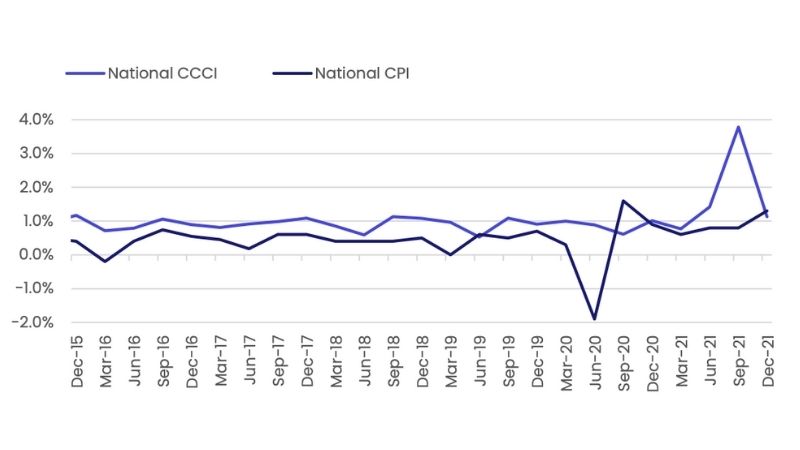The foundations of the Australian housing construction industry may not be crumbling but are looking decidedly shaky in the face of mounting problems driving some established builders to the wall.
The Federal government’s Homebuilder scheme had provided a temporary stimulus during trying pandemic times but has had the unintended side effect of denting supply of construction materials such as brick, timber and steel.
Some materials costs have gone up as much as 40 per cent, and myriad other issues are besetting the industry.
As well as housing construction costs hitting at an all-time high, building approvals have begun to stall, inflation is on its way up and pressure is mounting on interest rates. Labour shortages are pushing up costs substantially, and builders are warding off potential legal implications around contractual deadlines.
Highlighting the issue this week is the apparent collapse of Probuild, where hundreds of tradies have been booted off worksites across the country.
Speaking to Australian Property Investor Magazine, some of the most respected voices in the construction sector detailed their concerns and insights around the seemingly perfect storm enveloping the sector.

Maxwell Shifman, National President of the Urban Development Institute of Australia, said that inundated with work but facing cost blow-outs, the “profitless boom” brought about by the initial success of HomeBuilder has also exposed major underlying challenges for the industry.
“While house values have risen, costs have risen almost as fast, leaving some builders and developers who made sales based on fixed prices caught out,” Mr Shifman said.
“It has also primarily been focused on greenfields (a real estate construction project on previously undeveloped land), leaving apartment markets at severely diminished approval and completion rates compared to the prior peak.
“HomeBuilder has revealed two quite important things; firstly, the development and construction industry’s amazing ability to kickstart economic productivity, but secondly, that there are significant systemic issues such as thinning supply pipelines and planning/construction inefficiencies, which need to be fixed immediately to combat affordability problems and reduce economic drag as immigration levels return to normal.”
CoreLogic’s Cordell costing team estimate construction costs increased 7.3 per cent over the 2021 calendar year – the largest increase since 2005.

Research Director at CoreLogic, Tim Lawless, said the surge in approvals related to HomeBuilder is transitioning to actual construction activity and it will take some time for this ‘bulge’ in the pipeline of approved housing supply to work its way through to completion.
“It’s reasonable to expect these higher costs of land and materials will ultimately be passed on to the consumer in the form of more expensive new housing and costlier renovation projects,” he said.
“Some prospective buyers or renovators may simply delay or scrap their decision to engage with the market due to heightened costs and uncertainty of timing.
“For those already involved in a building or renovation project, there is a good chance they could be facing cost blowouts and/or delays in the project timing.”
National variations
More than 135,000 applications were made for the federal government stimulus package, with Victorians responsible for around 30 per cent of these.
The impact of supply bottlenecks has been huge but also varied – some trades and materials were barely impacted while others have been severely limited.
Mr Shifman said early on it was timber supplies which were severely restricted, though this appears to have abated somewhat in early 2022, due to a reducing number of new commencements from the peak and an increase in timber imports.
Steel prices also grew very substantially – over 30 per cent since the start of the pandemic – based on overseas price increases.
More recently, plasterboard has faced supply issues that have delayed fit outs and completions.
The various lockdowns around the country have also had a major impact, affecting some states more than others.
“Victoria was particularly strongly affected – while construction was able to continue through majority of the lockdown periods, restrictions such as the metro/regional ‘ring of steel’ and limits both on worker density and how many sites could be visited by trades during the week, severely delayed construction start and completion timeframes,” Mr Shifman said.

Alex Huang, APDA President
President of the Australian Property Developers Association (APDA), Alex Huang, said the larger capital cities were feeling the heat the most.
“Generally speaking, the larger population centres along the eastern and western seaboard of Australia traditionally have more demand compared to Tasmania, the ACT, Top End or South Australia, as these are places where more people want to build and settle in.
“With more demand, it will surely come with more pressure, so the material supply chain issue is felt nationwide but some states would undoubtedly have lesser labour hire issues than others and suffer less of a cost and time impact.”
Brakes and accelerators
While the Reserve Bank of Australia maintained a dovish stance on monetary policy, RBA governor Philip Lowe said while the omicron variant outbreak had delayed the recovery of the economy, he was confident it had not been derailed.

Alex Lim, APDA Secretary General
Alex Lim, APDA Secretary General, said the supply bottlenecks were an “extremely serious” issue in terms of delaying construction, affecting build quality and developers attracting and retaining new business and required a juggling act by government, banks and the RBA.
“Construction costs have increased dramatically and land prices have in turn also increased, all due to inflation, and now interest rate increases may cause a kneejerk reaction.
“We are waiting to see the banking sector response to the inflationary pressures to this temporary industry setback and the RBA’s cash rate will definitely need to be raised to keep inflation at bay,” Mr Lim said.
His colleague at APDA, Mr Huang, feared the dominoes could keep falling if government policy didn’t respond effectively.
“I see this more of a chain reaction setting off one after another, with the pandemic having forced many governments to introduce policies and stimulus that will ultimately cause inflation.
“The Australian government is trying to keep the economy alive while keeping inflation at bay.
“This is like trying to balance both feet on the gas and brake pedals at the same time but ultimately everything flows from the top down, with government policies dictating credit liquidity, interest rates, borders and labour hire availability.
“These will in turn affect the property prices and demand, which are the main levers of the residential construction sector,” Mr Huang said.
Construction hitting wall
A litany of builders have gone to the wall recently, some with debts in the tens of millions of dollars.
Pindan in Western Australia, Queensland-based builders Privium and BA Murphy, Melbourne-based high-rise builder ABD Group, and Tasmanian Constructions, a franchisee of Hotondo Homes, have all gone into liquidation, while Hobart-based Inside Out Construction folded in November.
News surfaced this week that around $5 billion worth of construction work is now under a cloud, with residential apartment and commercial builder Probuild on the verge of collapse.
Apartment and unit owner advocacy group, Australian Apartment Advocacy head Samantha Reece said a conga line of major builders are also likely to be facing financial difficulties.
“As usual, it may be apartment owners who have to foot the bill and we need to know where off the plan buyers are going to be left when all of this pans out,” Ms Reece said.
“Probuild’s problems may also spark the end of the line for many others in financial difficulty.”
“As rates start to also rise … there is likely to be an uptick in defaults by developers who are overleveraged on projects.” – Alex Jamieson
Interest rates had the potential to seriously impact the construction industry even further, according to Alex Jamieson of Melbourne-based AJ Financial Planning.
“From a consumer perspective, interest rates will have the largest impact on the residential construction industry,” he said.
“With the market pricing in around 1-2 per cent interest rate hikes, starting at the back end of the year, this will have a significant impact on borrower ability to service loans and how much the banks will permit them to borrow.
“Although the market is pricing in up to a 2 per cent move in rates, we feel due to the high borrowing levels it will struggle to push past 1 per cent, before really starting to hurt the consumer, as they will be very sensitive to the overall market.”
“As rates start to also rise, this will place funding pressures on the developers and there is likely to be an uptick in defaults by developers who are overleveraged on projects coupled with a flattening out of the property prices.
Consumer pays
It is reasonable to expect the higher costs of land and materials will ultimately be passed on to the consumer in the form of more expensive new housing and costlier renovation projects.
The Cordell costings team singled out structural timbers as the primary culprit of higher prices, but other materials such as metal goods have also seen a substantial rise in cost. Other materials are also showing higher than normal levels of volatility in their costs.
According to UDIA President, Mr Shifman, one clear implication is that builders are now reluctant to hold prices for more than six or so months before price increases apply.
“Previously, builders would fix prices for 12 months or even more in some cases,” he said.
“All this is before you factor in the ever-increasing approval delays, and the taxes and charges being levied by various state governments across the country.”
In terms of confronting the issues, Mr Shifman said development and construction industries are sensitive to many variables.
“Interest rate movements need to be carefully watched as they, coupled with macroprudential lending controls, strongly influence a buyer’s capacity to purchase,” he said
“With costs and prices at all-time highs, curbing lending capacity too quickly could have an enormous impact on the market – it depends on how deeply the rates impact borrowing and most critically, how it affects existing homeowners paying their mortgage.
“I would expect, however, that the rate of costs growth will moderate over the coming period.”
In terms of confronting the issues, Mr Shifman said interest rate movements need to be carefully watched as they, coupled with macroprudential lending controls, strongly influence a buyer’s capacity to purchase.
“With costs and prices at all-time highs, curbing lending capacity too quickly could have an enormous impact on the market – it depends on how deeply the rates impact borrowing and most critically, how it affects existing homeowners paying their mortgage.
“I would expect, however, that the rate of costs growth will moderate over the coming period.”
Population policy was also critically important, he said, in addressing growing labour shortages across many sectors, but also in underpinning the housing and construction industry, which employs some 1,143,000 Australians.
“The lack of population growth over the past two years, and the ending of HomeBuilder encouraging additional new supply/demand, could leave the industry severely diminished by the end of 2023.
“This would be disastrous for the broader economy as, according to the Australian Bureau of Statistics, every dollar spent on residential construction creates $2.90 of economic activity.
“It would be prudent for the Federal Government to continue to harness the growth driving capacity of the development and construction industry to strengthen the economy, smooth out the recovery and foster greater efficiencies in delivering new housing to market.
“Australia needs immigration to return to strong levels, and with the country’s overall health record and speedy recovery from the pandemic, we are surely at the top of many potential migrants’ lists as the place to come to live and work.”
Editor
Craig Francis
Australian Property Investor Magazine – February 22, 2022
